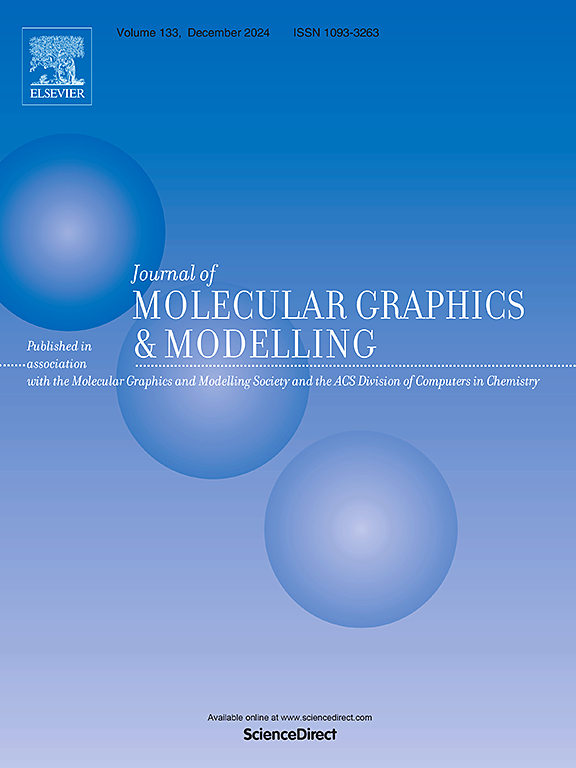Exploring the capabilities of metal-doped phthalocyanine (MPC, M = Co, Cu, Fe, Ni, Zn) for adsorption of CO2: A DFT study
IF 3
4区 生物学
Q2 BIOCHEMICAL RESEARCH METHODS
引用次数: 0
Abstract
Phthalocyanine-based covalent organic frameworks (PC-COFs) are a novel subclass of COFs that integrate phthalocyanine units to enhance electronic, optical, and catalytic properties. These frameworks are particularly effective in CO2 adsorption due to their high surface area, tunable porosity, and exceptional stability. In this study, we have employed density functional theory (DFT) calculations to explore the electronic properties of phthalocyanine doped with various metal centers (Co, Cu, Fe, Ni, Zn) and their impact on CO2 adsorption. The geometries of metal-doped phthalocyanines and their CO2 complexes were optimized using the B3PW91 functional with the LANL2DZ basis set. Adsorption energies, electronic structures, and reactivity indices such as HOMO-LUMO gaps, ionization potentials, and electron affinities were analyzed. The findings revealed that Fe-doped phthalocyanines exhibited the highest reactivity and strongest CO2 adsorption due to favorable charge transfer interactions. Additionally, aromaticity indices (HOMA and Bird) indicated enhanced aromatic character upon CO2 adsorption. These insights provide a foundation for designing more efficient PC-COF materials for CO2 capture, emphasizing the crucial role of electronic properties and metal center selection in optimizing adsorption performance.

探索金属掺杂酞菁(MPC, M = Co, Cu, Fe, Ni, Zn)吸附CO2的能力:DFT研究
基于酞菁的共价有机框架(PC-COFs)是一类新型的COFs,它整合了酞菁单元以增强电子、光学和催化性能。由于其高表面积、可调孔隙度和卓越的稳定性,这些框架在二氧化碳吸附方面特别有效。在本研究中,我们利用密度泛函理论(DFT)计算了掺杂不同金属中心(Co, Cu, Fe, Ni, Zn)的酞菁的电子性质及其对CO2吸附的影响。采用基于LANL2DZ基集的B3PW91泛函优化了金属掺杂酞菁及其CO2配合物的几何形状。分析了吸附能、电子结构和HOMO-LUMO间隙、电离势和电子亲和等反应性指标。结果表明,fe掺杂的酞菁表现出最高的反应活性和最强的CO2吸附,这是由于有利的电荷转移相互作用。此外,芳香性指数(HOMA和Bird)表明CO2吸附后芳香性增强。这些见解为设计更高效的PC-COF材料用于二氧化碳捕获提供了基础,强调了电子性能和金属中心选择在优化吸附性能中的关键作用。
本文章由计算机程序翻译,如有差异,请以英文原文为准。
求助全文
约1分钟内获得全文
求助全文
来源期刊

Journal of molecular graphics & modelling
生物-计算机:跨学科应用
CiteScore
5.50
自引率
6.90%
发文量
216
审稿时长
35 days
期刊介绍:
The Journal of Molecular Graphics and Modelling is devoted to the publication of papers on the uses of computers in theoretical investigations of molecular structure, function, interaction, and design. The scope of the journal includes all aspects of molecular modeling and computational chemistry, including, for instance, the study of molecular shape and properties, molecular simulations, protein and polymer engineering, drug design, materials design, structure-activity and structure-property relationships, database mining, and compound library design.
As a primary research journal, JMGM seeks to bring new knowledge to the attention of our readers. As such, submissions to the journal need to not only report results, but must draw conclusions and explore implications of the work presented. Authors are strongly encouraged to bear this in mind when preparing manuscripts. Routine applications of standard modelling approaches, providing only very limited new scientific insight, will not meet our criteria for publication. Reproducibility of reported calculations is an important issue. Wherever possible, we urge authors to enhance their papers with Supplementary Data, for example, in QSAR studies machine-readable versions of molecular datasets or in the development of new force-field parameters versions of the topology and force field parameter files. Routine applications of existing methods that do not lead to genuinely new insight will not be considered.
 求助内容:
求助内容: 应助结果提醒方式:
应助结果提醒方式:


